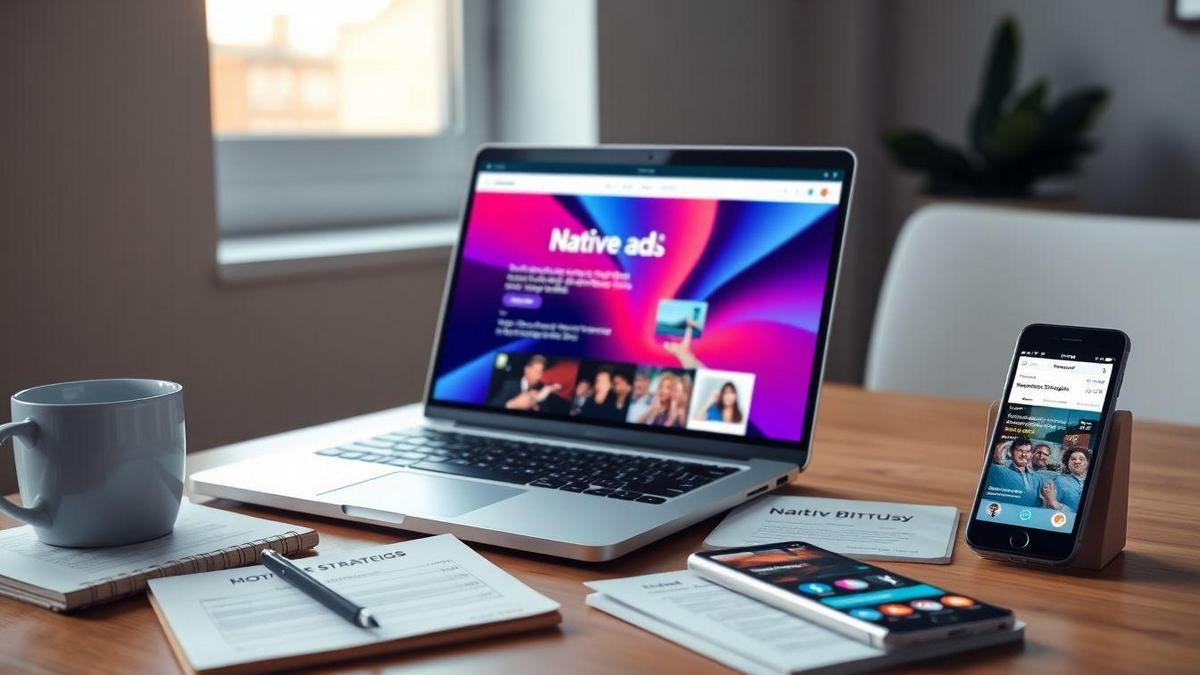Welcome to Native Ads: How to Apply and Why They Work! If you’re curious about native advertising, you’re in the right place. This article will break down the basics of native ads, show you how they differ from traditional ads, and reveal key features that make them effective. You’ll discover their benefits for your brand, learn how to apply them, and find out what makes some ads truly stand out. Plus, we’ll share helpful tips and common mistakes to avoid. Let’s dive in!

Understanding Native Ads: What You Need to Know
The Basics of Native Advertising
Native advertising is a sneaky way to promote products or services. It blends in with the content you’re already reading or watching, making it feel like a part of the experience. Instead of standing out like a sore thumb, native ads fit in like a puzzle piece. They are often found in social media feeds, articles, or even videos, and they aim to provide value while subtly promoting something.
How Native Ads Differ from Traditional Ads
Traditional ads are like that loud friend at a party who just won’t stop shouting for attention. They pop up, interrupt your flow, and demand you look at them. Native ads, on the other hand, are the smooth talkers who engage you in conversation. Here’s how they stack up against each other:
| Feature | Native Ads | Traditional Ads |
|---|---|---|
| Appearance | Blends with content | Stands out, often disruptive |
| Engagement | Encourages interaction | Often ignored or skipped |
| Value | Provides useful information | Primarily promotional |
| Placement | Found within content | Usually separate and obvious |
Key Features of Native Ads
When you think about native ads, remember these key features:
- Relevance: They relate to the content around them, making them feel natural.
- Non-disruptive: You can read or watch without interruption.
- Engaging: They often tell a story or provide useful information, keeping you interested.
- Variety: They come in many forms, from sponsored articles to social media posts.
By understanding these features, you can better appreciate how native ads work and why they can be effective.
Benefits of Native Advertising for Your Brand
Increased Audience Engagement
When you think about getting your message across, audience engagement is key. Native ads blend in with the content that your audience loves, making them more likely to stop and take notice. Imagine scrolling through your favorite website, and instead of seeing a loud banner ad, you come across an article that speaks directly to your interests. That’s the power of native ads! They catch your eye without feeling like an interruption.
Improved Brand Awareness
Native ads can also boost your brand awareness. Since they fit seamlessly into the content, people start to recognize your brand without even realizing it. Think of it like this: if you see a brand’s name popping up in articles that you read regularly, it sticks in your mind. Over time, this familiarity builds trust. And trust is what makes people choose your brand over others.
Why Brands Choose Native Ads
So, why do so many brands opt for native ads? Here’s a quick look at some reasons:
| Reason | Description |
|---|---|
| Less Distracting | They don’t scream ad like traditional ads do. |
| Higher Click-Through | More people click on them compared to standard ads. |
| Better Storytelling | They allow brands to tell their story in a creative way. |
In short, native advertising isn’t just a trend; it’s a smart choice for brands looking to connect with their audience in a meaningful way.

How to Apply Native Ads Effectively
Steps to Create Compelling Native Ads
Creating compelling native ads is all about blending in while standing out. Here’s a simple roadmap to guide you:
- Know Your Audience: Understand who you are talking to. What do they like? What problems do they face? Tailoring your message to their needs is crucial.
- Craft Engaging Content: Write headlines that grab attention. Use images that speak volumes. Your content should feel like a conversation, not a sales pitch.
- Choose the Right Format: Whether it’s an article, video, or social media post, pick a format that suits your audience’s preferences.
- Test and Optimize: Don’t just set it and forget it. Monitor your ads and tweak them based on what works. If something isn’t resonating, change it up!
Choosing the Right Platforms for Native Ads
Not all platforms are created equal. Here’s how to pick the best ones for your native ads:
| Platform | Audience Type | Best for |
|---|---|---|
| General Audience | Engaging visuals and stories | |
| Younger Demographics | Eye-catching images and videos | |
| Professionals | B2B content and articles | |
| News Seekers | Quick updates and insights |
Think about where your audience spends their time. Are they scrolling through Instagram, or are they reading articles on LinkedIn? Choose wisely!
Best Practices for Applying Native Ads
To make your native ads shine, follow these best practices:
- Stay Authentic: Your ad should feel like part of the content. Avoid hard-selling; instead, provide value.
- Keep It Simple: Don’t overcomplicate your message. Clear, concise information works best.
- Use Strong Visuals: A picture is worth a thousand words. Use high-quality images that grab attention.
- Call to Action: Don’t forget to tell your audience what to do next. Whether it’s Learn More or Sign Up, make it clear.
By following these steps and practices, you can make your native ads not just effective, but also enjoyable for your audience.
Examples of Successful Native Ads
Case Studies of Effective Native Ads
When you think about native ads, you might picture a seamless blend of content and promotion. Let’s dive into some real-life examples that hit the mark!
- BuzzFeed and Coca-Cola: BuzzFeed created a fun quiz titled Which Coca-Cola Are You? This ad didn’t just push a product; it engaged readers. People loved sharing their results, which spread the word about Coca-Cola without feeling like a hard sell.
- The New York Times and Netflix: Netflix partnered with The New York Times for a beautifully written article about the making of a popular show. It felt like a genuine story rather than an ad, making readers curious about the series.
- Red Bull’s Adventure Stories: Red Bull often shares thrilling stories about extreme sports. These aren’t just ads; they’re captivating tales that pull you in, showcasing the brand’s adventurous spirit.
Learning from Top Brands’ Native Ad Campaigns
Top brands know how to craft their native ads. Here are a few lessons you can learn from them:
- Be Authentic: People connect with real stories. Your ads should feel genuine and relatable.
- Engage Your Audience: Think about how to spark interest. Quizzes, stories, and interactive content can keep your audience hooked.
- Blend In: Your ad should match the style of the platform. If it looks like part of the content, readers are more likely to engage.
What Makes These Ads Stand Out
What sets these ads apart? Here’s a quick look:
| Element | Description |
|---|---|
| Storytelling | They tell a story that resonates with the audience. |
| Visual Appeal | Eye-catching images or videos draw people in. |
| Relevance | Content is relevant to the audience’s interests. |
| Call to Action | A clear, inviting next step encourages interaction. |

Effective Native Advertising Strategies
Tailoring Content for Your Audience
When you think about native ads, remember that they should feel like a natural part of the content your audience already loves. It’s like inviting a friend to a party; you want them to feel comfortable and engaged. To do this, you need to know who your audience is.
Ask yourself questions like:
- What are their interests?
- What problems do they face?
- What type of content do they enjoy?
Once you have these answers, you can create content that resonates with them. For example, if your audience loves cooking, a native ad featuring a recipe or cooking tips will fit right in. This way, your ads won’t just be ads; they’ll be valuable content that your audience wants to consume.
Using Data to Optimize Native Ads
Data is your best friend when it comes to making your native ads work better. Think of it like a treasure map guiding you to success. By looking at data, you can see what’s working and what’s not. Here are some key data points to track:
| Data Point | What to Look For |
|---|---|
| Click-Through Rate | How many people are clicking your ads? |
| Engagement Rate | Are people interacting with your content? |
| Conversion Rate | Are people taking action after seeing the ad? |
By analyzing these numbers, you can tweak your ads to fit your audience’s needs. If you see that a certain style of ad is getting more clicks, you might want to create more of that type. It’s all about being flexible and ready to change course based on what the data tells you.
Strategies for Boosting Native Ad Performance
Boosting your native ad performance is like tuning a musical instrument; small adjustments can lead to a big difference. Here are some strategies to consider:
- A/B Testing: Try out different versions of your ads to see which one performs better.
- Targeting: Use demographic and interest-based targeting to reach the right people.
- Quality Content: Make sure your content is high-quality and provides real value.
By following these strategies, you can enhance the effectiveness of your native ads. Remember, the goal is to create ads that feel like a part of the content, not just a sales pitch.
Measuring the Performance of Native Ads
Key Metrics to Track
When it comes to measuring the performance of your native ads, there are a few key metrics you should keep an eye on. Tracking these will help you understand how well your ads are doing and guide your next steps. Here’s a quick list of what to focus on:
- Click-Through Rate (CTR): This tells you how many people clicked on your ad compared to how many saw it. A higher CTR means your ad is catching attention.
- Conversion Rate: This shows the percentage of users who completed a desired action after clicking your ad, like making a purchase or signing up for a newsletter.
- Engagement Rate: This measures how users interact with your ad. Are they liking, sharing, or commenting? More engagement means your content is resonating.
- Cost Per Acquisition (CPA): This tracks how much you spend to gain a customer. Lower CPA is what you’re aiming for!
- Return on Investment (ROI): This is all about the money. Are you making more from your ads than you’re spending? If yes, you’re on the right track!
Tools for Analyzing Native Ad Effectiveness
To make sense of all these metrics, you’ll need some handy tools. Here are a few that can help you analyze your native ads effectively:
| Tool | Description |
|---|---|
| Google Analytics | A powerful tool for tracking website traffic and conversions. You can see how your ads are performing on your site. |
| AdEspresso | Great for managing and optimizing Facebook and Instagram ads. It provides insights into ad performance. |
| HubSpot | Offers a comprehensive view of your marketing efforts, including native ads. It can help you track leads and ROI. |
| BuzzSumo | Helps analyze content performance across social media and can give insights on how your native ads are engaging users. |
Understanding ROI on Native Ads
Understanding your ROI on native ads is crucial. It’s not just about how much you spend but what you gain in return. To calculate your ROI, use this simple formula:
[ text{ROI} = frac{text{Net Profit}}{text{Total Investment}} times 100 ]
For example, if you spent $100 on an ad and made $300 in sales, your net profit is $200. Plugging that into the formula gives you:
[ text{ROI} = frac{200}{100} times 100 = 200% ]
That’s a great return! Knowing your ROI helps you decide if your ad strategy is working or if it’s time to tweak things.

Enhancing Content Marketing with Native Ads
Integrating Native Ads into Your Content Strategy
When you think about content marketing, have you ever considered using native ads? These ads blend seamlessly with the content on the platform, making them feel like a natural part of the user experience. This means they can grab attention without being overly intrusive.
To integrate native ads into your content strategy, start by identifying where they can fit. Here are some tips:
- Choose the Right Platforms: Look for sites where your target audience hangs out.
- Match the Tone: Your ads should reflect the voice of the content around them.
- Be Subtle: The goal is to inform, not to shout.
By doing this, you can create a smooth flow that keeps readers engaged while subtly promoting your brand.
The Role of Storytelling in Native Advertising
Storytelling is a powerful tool in native advertising. It allows you to connect with your audience on a personal level. When you share a story, you invite readers into a narrative that resonates with their experiences.
Consider this: instead of simply pitching a product, tell a story about how it solved a problem for someone. This approach makes your ads feel less like advertisements and more like valuable content.
Here’s how storytelling can enhance your native ads:
- Emotional Connection: Stories evoke feelings, making your message memorable.
- Relatability: Readers can see themselves in the story, which builds trust.
- Engagement: A good story keeps readers interested, encouraging them to read more.
Creating Value Through Native Content
Creating value is at the heart of native advertising. Your content should provide insights or entertainment while subtly promoting your brand. Think about what your audience wants to know.
Here’s a simple table to help you understand how to create value through native content:
| Type of Content | Value Offered |
|---|---|
| How-to Guides | Practical tips and solutions |
| Case Studies | Real-life examples that inspire trust |
| Listicles | Quick, digestible information |
| Expert Interviews | Insights from industry leaders |
By focusing on these types of content, you not only engage your audience but also position your brand as a valuable resource.
The Future of Native Advertising
Trends Shaping Native Ads
Native advertising is changing fast. You might have noticed how ads blend with content, making them feel more like part of the experience. This trend is growing, and here are a few key points to consider:
- Personalization: Ads are getting smarter. They use data to show you what you like. Think about it—ever see an ad that felt like it was made just for you? That’s personalization at work.
- Mobile Focus: More people are browsing on their phones. Ads that fit well on mobile screens are becoming the norm. If you’re not considering mobile, you might be missing out.
- Video Content: Videos are everywhere! They grab your attention and keep you engaged. Native ads using videos are likely to draw in more viewers.
- Social Media Integration: Platforms like Instagram and Facebook are where many people spend their time. Ads that look like regular posts can be more effective.
Predictions for Native Advertising Growth
Looking ahead, native advertising is set to grow even more. Here’s what you can expect:
| Prediction | Details |
|---|---|
| Increased Spending | Companies will invest more in native ads. |
| More Innovative Formats | Expect new and creative ways to present ads. |
| Better Measurement Tools | Tools to track success will become more advanced. |
| Stronger Regulations | As it grows, expect more rules to follow. |
Preparing for Changes in Native Advertising
To keep up with these changes, you’ll want to stay informed. Here are some tips:
- Follow Industry News: Keep an eye on trends and updates in advertising.
- Test New Formats: Don’t be afraid to try new ad styles. What works today might not work tomorrow.
- Engage with Your Audience: Build a community. When your audience feels connected, they’re more likely to respond to ads.

Common Mistakes to Avoid with Native Ads
Misunderstanding Audience Intent
When diving into native ads, it’s crucial to grasp what your audience is really after. If you miss the mark here, your ads can flop. Think about it: when someone clicks on an ad, they’re looking for something specific. If your content doesn’t meet their expectations, they might feel tricked or frustrated.
For example, if you’re selling a new gadget but your ad talks about unrelated topics, you’re bound to lose their interest. Instead, make sure your content aligns with what your audience is searching for.
Overly Promotional Content in Native Ads
No one enjoys being bombarded with ads that scream “buy me!” If your native ads come off as too promotional, people will scroll right past them. You want your content to feel like a conversation, not a sales pitch.
Think about how you feel when you read an article that’s just a big advertisement. It’s off-putting, right? Instead, aim for a balance. Share valuable information, tell a story, or offer insights that resonate with your audience.
Tips to Avoid These Pitfalls
Here are some handy tips to help you steer clear of these common mistakes:
| Tip | Description |
|---|---|
| Know Your Audience | Research what they care about and tailor your content. |
| Be Authentic | Write in a natural tone that feels genuine and relatable. |
| Focus on Value | Provide useful insights instead of just selling a product. |
| Test and Learn | Experiment with different approaches to see what works best. |
By keeping these tips in mind, you can create native ads that truly connect with your audience and drive results.
Frequently Asked Questions
What are native ads?
Native ads are ads that blend in with your content. They look like regular articles but promote something.
How do I apply native ads to my website?
To apply native ads, choose a platform. Sign up, pick your ads, and place the code on your site.
Why do native ads work?
Native ads work because they match the look and feel of your site. People are more likely to engage with them.
Can I track the performance of my native ads?
Yes, you can track them! Use analytics tools to see clicks and engagement. This helps you see what’s working.
Do native ads affect my SEO?
Native ads can help your SEO by increasing user engagement. Higher engagement can get you more traffic over time.

Marina is a passionate web designer who loves creating fluid and beautiful digital experiences. She works with WordPress, Elementor, and Webflow to create fast, functional, and visually stunning websites. At ReviewWebmaster.com, she writes about tools, design trends, and practical tutorials for creators of all levels.
Types of articles she writes:
“WordPress vs. Webflow: Which is Best for Your Project?”
“How to Create a Visually Stunning Website Without Hope”
“Top Landing Page Design Trends for 2025”
Why it works:
She brings a creative, accessible, and beginner-friendly perspective to the blog, perfectly complementing Lucas’s more technical and data-driven approach.
